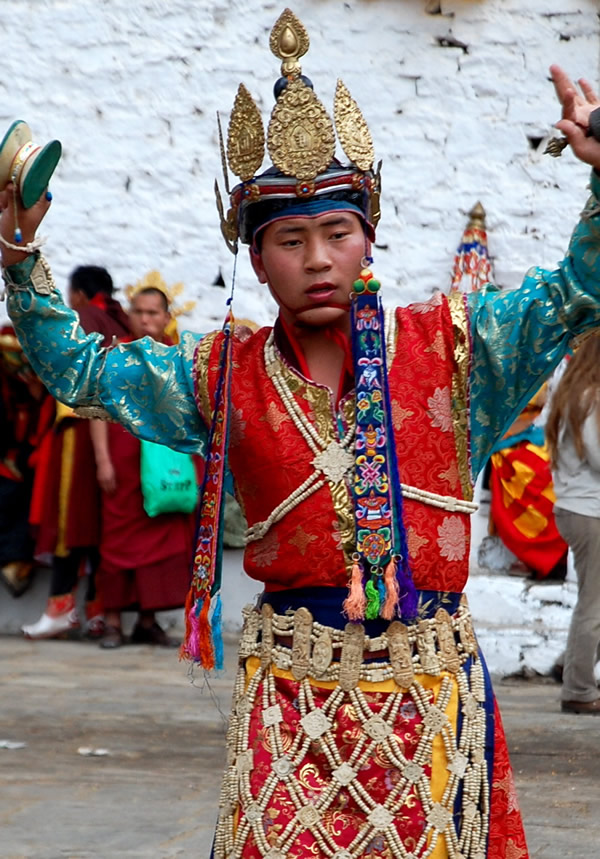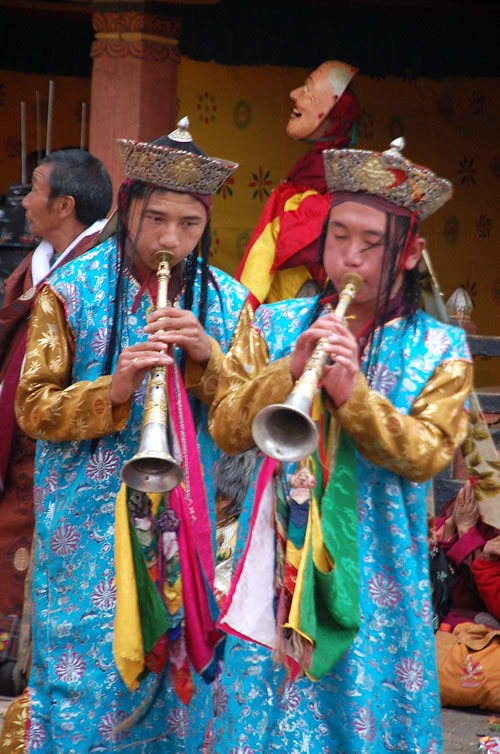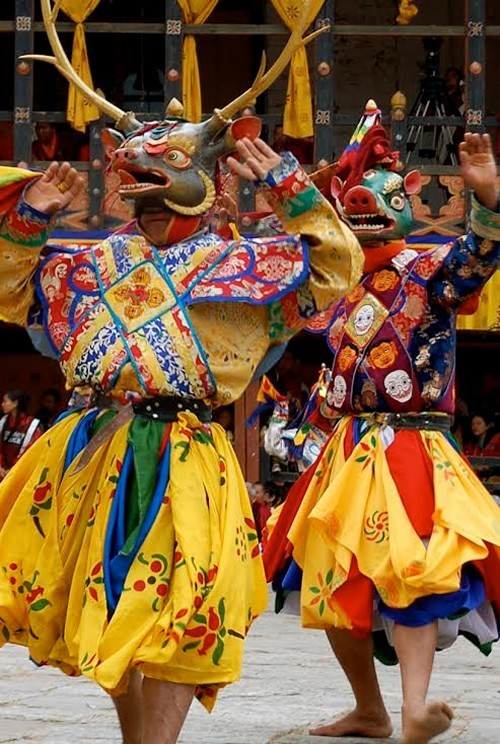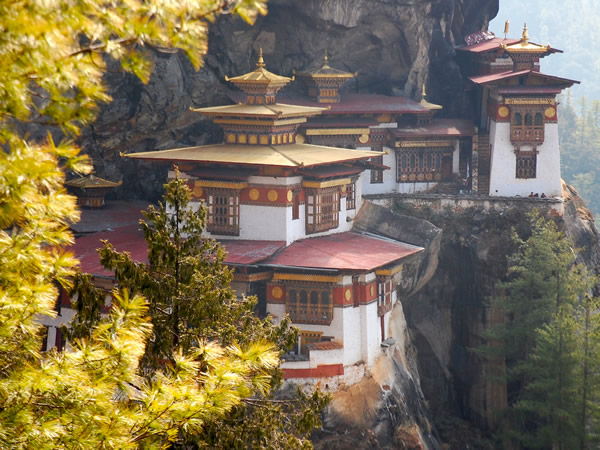Bhutan’s Paro Tshechu Festival
An Expression of Gross National Happiness in the Land of the Thunder Dragon
Article and photos by Lies Ouwerkerk
Senior Contributing Editor
 |
| Paro festival: dancer with hand bells. |
When the 4th king of Bhutan, Jigme Singye Wangchuck, declared in the 70’s that Gross National Happiness (GNH) was more important than Gross Domestic Product (GDP) and decided to make the wellbeing of his people the top priority of national policy, he might not have foreseen that this unique vision of a prosperous and healthy society would attract a growing number of curious visitors to his relatively unknown country in the Eastern Himalayas, eager to experience “world’s last Shangri-la," as Bhutan often has been dubbed. About 5,000 foreigners visited the country in 1990. Until the pandemic of 2020, up to 300,000 tourists entered Bhutan yearly. There is a daily visitor Responsible Development Fee (SDF) of $100 a day post-pandemic, lowered from $250 in 2022. You will need a minumum of $100 for lodging, meals, transport, and guides.
World’s Last Utopian Society?
Those with a traditional view of the utopian concept may be somewhat confused at first. Granted, the scenery of pristine mountains, misty forests and fertile valleys dotted with castle-like dzongs (fortresses), temples, monasteries, and pagodas, and set against the backdrop of the snowy Himalaya peaks, is absolutely spectacular. Nevertheless, from a Western standpoint, life in Bhutan seems much like that in many other less developed countries, with the same struggles and daily hardships people face elsewhere. The majority of the merely 770,000 inhabitants live of cultivation (rice, barley, mustard, vegetables) and livestock rearing (poultry, cattle, pigs), with home consumption as their main purpose. Although there is no famine, housing is generally adequate, and education and healthcare are free, about one fifth of the population lives below the poverty line, with another fifth (South Bhutanese) still in limbo or relocating to Nepal, Europe, and the United states after more than 20 years in Nepalese refugee camps.
Proper infrastructure is still in its infancy. There is only one 2-lane highway from east to west, and one airport with a tiny landing strip and a fleet of two jet airliners.
To Have or To Be
Once more immersed in Bhutanese life, however, a more complete picture starts to emerge. The kindness, respect, and patience of the people is absolutely exemplary and awe-inspiring, and it seems that their way of life is not so much shaped by the money they make or by the material goods they can afford, but by nobler ambitions such as commitment to the well-being of the community, compassion and altruism, harmony and a positive mindset, promotion of eco-consciousness and sustainable development, and above all: preservation of all aspects of Bhutan’s traditional culture.
Traditions in Bhutan
Bhutan’s traditions are expressed in a variety of ways including the national language Dzongka, which was until about half a century ago only an oral language, the national dress (the gho, a robe with a cloth belt tied around the waist for men, and the kira, an ankle-length dress for women), the fundamental role of the Buddhist faith (there are about 7,000 subsidized monks and more than 2,000 temples in the country), the immensely popular national sport of archery, which dates back many centuries, and the 13 traditional arts and crafts, passed down from generation to generation and still taught according to traditional criteria at the Institute of Zorig Chosum in Thimpu. However, by far the most important manifestations of Bhutanese tradition are undoubtedly the many yearly celebrations and ceremonies, both secular and religious, of which the Tshechus are best known.
Paro Tshechu
My visit to Bhutan takes place in the month of March when blossom trees and magnolias are just burgeoning and the annual Paro Tshechu is celebrated. This famous festival, originally a consecration ceremony of the Dzong Paro Rinpung in the mid 17th century, is now held annually to honor the enlightened Guru Rinpoche, the “Lotus-Born Teacher” who established Buddhism in Tantric form in the Himalaya regions in the 8th century.
Through dance, folksongs, and music (cymbal, drum, flute, yak-horn) performed by both laity and monks, the sacred activities of the Guru, with whom most Bhutanese feel a deep connection, are re-enacted and celebrated for 5 consecutive days.
The festival is also an opportunity to reconnect with family, friends, and acquaintances or establish new ties, to see and be seen in one’s finest clothing and jewelry, and above all, to accumulate merits. For through festival attendance one can create good karma and move forward to enlightenment, the ultimate goal of Buddhists.
 |
| Musicians at Paro festival. |
Blessings from the Thongdrol
The chance to accumulate merits is the also the reason why in the wee morning hours of the 5th day — which coincides with the full moon of the second lunar month — devotees of all corners of Bhutan and beyond, flood the grounds of the Paro dzong to receive blessings from world’s largest Thongdrol, an enormous embroidered thangka (scroll painting) depicting Guru Rinpoche, his eight major manifestations, his consorts, and his religious masters. This huge appliqué is only revealed once a year during the Paro Tshechu, unfurled on an entire side of the five-storey temple near de dzong, and re-rolled before sunrays get a chance to touch the centuries-old brocade.
For many, lining up with their prayer cords in hand in front of the image of the Guru, getting a chance to touch the sacred fabric, and receiving its blessings to be liberated from sin and evil, signifies the absolute highlight of the festival.
Dances
In the exterior courtyard of the Paro dzong, a constant stream of fancifully dressed dancers passes my eyes once I have finally mastered a seat with a good vantage point amidst the crowd. Ritual dances with evocative titles such as “Dance of the Lords of Cremation Grounds,” “Dance of the Terrifying Deities,” and “Dance of the Noblemen and the Ladies” are performed according to a fixed sequence that like the colorful outfits, headdresses, and masks has remained virtually unchanged through the centuries. Most of them depict the various manifestations of Guru Rinpoche in his endeavor to introduce Buddhism in the region. Particularly powerful are the dances in which he is transformed into wrathful appearances to tame evil spirits or harmful deities. All accompanying attributes of the dancers have particular significance as well: a drum can represent victory over evil spirits or delusions, a sword may symbolize wisdom that cuts through all obstacles with one single stroke, and hand bells are supposed to awaken all sentient beings from ignorance.
 |
 |
|
Paro festival: Ritual dance of the Noblemen and the Ladies.
|
Atsaras, the Jesters of the Festival
Indispensable to the Tshechu are a couple of eccentric clowns, called atsaras, who liven up the festival with their witty, whimsical, and sometimes lewd behavior, their exaggerated dance movements, and their tricks with which they involve, tease, and entertain the crowd. Dressed in bright colors, they wear a red wooden mask with a hawkish nose, a permanent mischievous grin, and a big phallus on top. They actually represent ancient holy teachers of India, the Acharyas, and one explanation for their burlesque appearance is, to remind us that we can reappear in any possible form in the future. Others suggest that they act and dress this way to show the true path of enlightenment in a humorous way, or to uproot evil from the mind of mortals with the power of humor.
However, the atsara is more than just a symbol or jester who brings happiness to his spectators. Usually he is, if not an accomplished dancer, at least very knowledgeable about all the dances, their movements, rituals, and sequences. His responsibilities can vary from getting dancers quickly on track when they make mistakes or helping them to adjust their attire, to explaining the meaning of masks to spectators, helping to control the crowds, or entertaining them in between dances when performers are still in the changing room.
Paro and Beyond
It is easy to get caught up in the frenzy of this fascinating spectacle and put the rest of Bhutan’s highlights on the backburner. It would be a pity, though, to miss out on a visit to the Taktshang Pelphug, the “Tiger’s Nest,” a highly spiritual place clinging to a dark grey rock high above the Paro valley. Many saints came here to meditate — including Guru Rinpoche — and it became one of the most important pilgrim sites in the Himalayas. In addition, the Kyichu Lhakhan temple, built in 659 is nearby, and if you are as lucky as I was, you can witness a cremation ceremony on the same grounds, and learn about the bardo, the time the spirit is on its journey toward reincarnation and cared for by the family until the 49th day.
 |
| Tiger's Nest Monastery. |
The city of Thimpu with its marvelous Tashichoed dzong, is a 2-hour drive from Paro; the most beautiful dzong of Bhutan can be seen in Punakha; and the spacious Bumthang valley with its friendly villages and numerous monasteries further to the east is definitely worth a visit as well. This is also the region where the average hiker can still get a chance, as most other trekking areas in Bhutan are rather challenging and reserved for the highly adventurous and more experienced.
Good Info to Know About Bhutan
- The national currency is the ngultrum. It has the same value as the Indian rupee, which is accepted everywhere as well
- Credit cards and AMT’s are relatively rare, so it is important to bring enough cash
-
Visas are not issued outside Bhutan, but are obtained through government-controlled tour agencies, who handle all the preliminary proceedings before one enters the country (see the The Tourism Council of Bhutan)
- English is widely spoken, especially by the young
|
Lies Ouwerkerk is originally from Amsterdam, The Netherlands, and currently lives in Montreal, Canada. Previously a columnist for The Sherbrooke Record, she is presently a freelance writer and photographer for various travel magazines.
|
